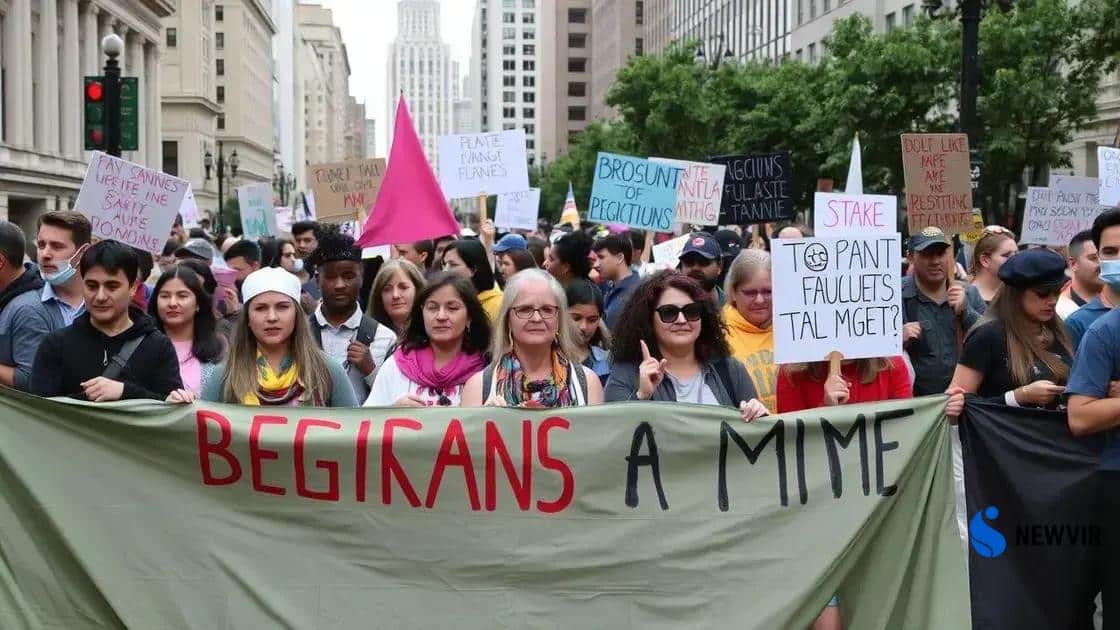Hands off grassroots protest campaigns that spark change

Grassroots protest campaigns leverage community engagement and social media to drive social change, effectively mobilizing local support while overcoming challenges through strategic organizing and adaptability.
Hands off grassroots protest campaigns are gaining momentum, empowering ordinary people to enact real change. Have you ever wondered how these movements start and grow? Let’s explore their impact.
Understanding grassroots protest campaigns
Understanding grassroots protest campaigns is essential in today’s world. These movements empower individuals to unite for a common cause and drive change. Grassroots activism often begins at the community level, where local issues can spark nationwide movements.
Key Characteristics of Grassroots Campaigns
Grassroots campaigns are defined by their community-driven nature. They rely on the passion of individuals who are directly impacted by social issues.
- Local Engagement: Activists often start by addressing challenges within their own neighborhoods.
- Volunteering: Grassroots campaigns typically depend on volunteers who share their time and energy.
- Collective Action: These movements emphasize teamwork and collective efforts to achieve goals.
As movements grow, they often gain support from social media, allowing them to reach wider audiences. Using platforms like Twitter and Facebook, activists can share their messages effectively. This access to technology creates opportunities for connection and mobilization.
Stages of a Grassroots Campaign
Every grassroots campaign follows several stages. Recognizing these steps can help activists plan effectively.
- Awareness: Highlighting the issue to attract attention.
- Organizing: Gathering supporters to strategize actions.
- Mobilizing: Encouraging community members to participate in events.
From awareness to mobilization, grassroots campaigns adapt to their audiences. Whether aiming for local reforms or national policy changes, they seek to unite voices and foster community spirit. With determination and collaboration, these initiatives can lead to significant social change.
Key strategies for organizing effective protests
Key strategies for organizing effective protests can make a big difference in achieving goals. Protests don’t just happen; they require planning and collaboration. Understanding how to engage your community is vital for success.
Identifying Objectives
Start by clearly defining the goals of your protest. Knowing what you want to achieve helps guide your planning. Each protest should focus on a specific issue that resonates with your audience.
- Be Specific: Define the issue clearly so people understand your cause.
- Make It Relevant: Connect the protest to current events or local concerns.
- Set Measurable Goals: Determine what success looks like for your protest.
Once you have your objectives, mobilizing supporters is next. You want your message to reach as many people as possible. Utilize social media channels to create buzz and encourage participation. Share your goals, the date, and how people can get involved.
Building a Core Team
A strong core team is essential for effective organization. Gather motivated individuals who share your passion. Divide tasks among team members according to their strengths. This makes the organizing process smoother and more efficient.
- Assign Roles: Choose leaders, communicators, and logistics coordinators.
- Encourage Collaboration: Create an environment where all voices are heard.
- Regular Meetings: Hold consistent meetings to keep everyone informed.
As the protest date approaches, keep supporters engaged. Send updates and reminders to maintain excitement. Consider hosting smaller events leading up to the main protest. These can build momentum and strengthen community ties before the big day.
Remember that adaptability is crucial in organizing protests. Challenges may arise that require quick thinking and flexibility. Stay open to feedback and be willing to adjust plans when necessary. Keeping communication open helps foster a sense of unity among participants, making the protest more powerful.
The role of social media in grassroots movements

The role of social media in grassroots movements is crucial for mobilization and awareness. Today, platforms like Facebook, Twitter, and Instagram allow activists to share messages rapidly. These tools help build communities around causes and create connections that might not happen otherwise.
Connecting with Supporters
Social media allows grassroots campaigns to connect with supporters easily. By sharing stories, images, and updates, activists can engage followers and attract new participants. Posts about upcoming events or protests can spread quickly, reaching those who may not be aware of the issue.
- Real-time Updates: Activists can inform supporters about changes in plans or new developments.
- Storytelling: Sharing personal stories creates emotional connections and highlights the campaign’s importance.
- Visual Content: Images and videos often garner more engagement than text-only posts.
Through hashtags, movements can become trending topics, capturing the attention of larger audiences. This visibility is important for drawing awareness to particular causes, often leading to increased support. Hashtags also help organize conversations, making it easier for people to find relevant content.
Organizing Events
Social media is not just about sharing information; it is also a powerful tool for organizing events. From rallies to protests, platforms enable quick and efficient planning. Event pages can be created, allowing participants to RSVP and share with their networks.
- Invitations: Users can invite friends, expanding the reach of the event.
- Coordination: Social media provides a space for discussing logistics and sharing resources.
- Promoting Engagement: Engaging content keeps participants excited and motivated as the event approaches.
Overall, social media enhances the effectiveness of grassroots movements. It creates a platform for dialogue, fosters community, and draws attention to important issues. By leveraging these tools, activists can amplify their voices and drive significant change in society.
Case studies: Successful grassroots movements
Case studies of successful grassroots movements offer powerful lessons on how ordinary people can bring about change. By examining these examples, we can learn how effective strategies and community engagement lead to victories.
Examples of Impactful Grassroots Movements
Many grassroots movements have shaped history, demonstrating the strength of collective action. Let’s take a look at a few prominent examples.
- Civil Rights Movement: In the 1950s and 60s, activists fought against racial segregation and discrimination in the United States. Leaders like Martin Luther King Jr. inspired people to join peaceful protests, resulting in significant legislative changes.
- Environmental Movement: This movement gained momentum in the late 20th century, focusing on issues like pollution and climate change. Organizations such as Greenpeace were pivotal in raising awareness and advocating for policy changes.
- Women’s Suffrage Movement: This campaign fought for women’s right to vote in the early 20th century. Activists organized rallies, marches, and petitions, ultimately leading to the passage of the 19th Amendment in the U.S.
These case studies showcase the power of grassroots activism. They illustrate how ordinary people can unite for common goals and influence decision-makers. By mobilizing grassroots efforts, movements often gain traction and visibility in the media.
Strategies for Success
Successful movements often share key strategies that contribute to their effectiveness. Recognizing these strategies can help future campaigns thrive.
- Building a Solid Network: Strong connections among community members and organizations create a support system that amplifies voices.
- Effective Communication: Clear messaging and storytelling resonate with the public, making the cause relatable and engaging.
- Utilizing Media: Grassroots movements leverage traditional and social media to share their messages widely, drawing attention to their causes.
By learning from these historical examples, activists today can apply proven strategies to their own grassroots movements. The success of past campaigns serves as an inspiration to foster collective action, drive social change, and empower communities.
Overcoming challenges in grassroots activism
Overcoming challenges in grassroots activism is essential for sustaining momentum and achieving goals. Activists often face various obstacles, but addressing these challenges can strengthen their movements.
Common Challenges Faced by Activists
Grassroots activists encounter common issues that can affect their efforts. Identifying these obstacles is the first step toward overcoming them.
- Lack of Funding: Many grassroots movements operate on tight budgets, making it difficult to pay for events or promotional materials.
- Public Apathy: Engaging those who are indifferent to the cause can be a significant hurdle.
- Internal Conflict: Disagreements within a team can hinder progress and disrupt collaboration.
To succeed, activists must be adaptable and resourceful. Building a strong network of allies can provide both support and solutions. Collaboration with local businesses, other organizations, or community leaders can increase resources and visibility.
Effective Strategies to Address Challenges
Implementing effective strategies can help grassroots activists navigate and overcome these challenges. It is crucial to remain proactive and flexible.
- Fundraising Initiatives: Organizing fundraising events or online campaigns can help generate the necessary funds for activities.
- Awareness Campaigns: Engaging the community through educational initiatives can raise interest in the cause and encourage support.
- Conflict Resolution: Establishing clear communication channels and conflict resolution methods can help maintain team harmony.
Adopting these strategies allows activists to focus on their mission. Each challenge presents an opportunity for learning and growth. By remaining committed and persistent, grassroots movements can not only survive but thrive, inspiring others along the way.
FAQ – Frequently Asked Questions about Grassroots Activism
What is grassroots activism?
Grassroots activism refers to community-driven efforts aimed at promoting social change through direct involvement and engagement.
How can I get involved in a grassroots movement?
You can get involved by finding local groups that align with your values, attending meetings, and participating in events.
What are some effective strategies for grassroots organizing?
Effective strategies include building a strong network, using social media for outreach, and conducting awareness campaigns to engage the community.
What challenges do grassroots movements face?
Grassroots movements often face challenges such as limited funding, public apathy, and internal conflicts, but these can be overcome with clear communication and resourcefulness.






